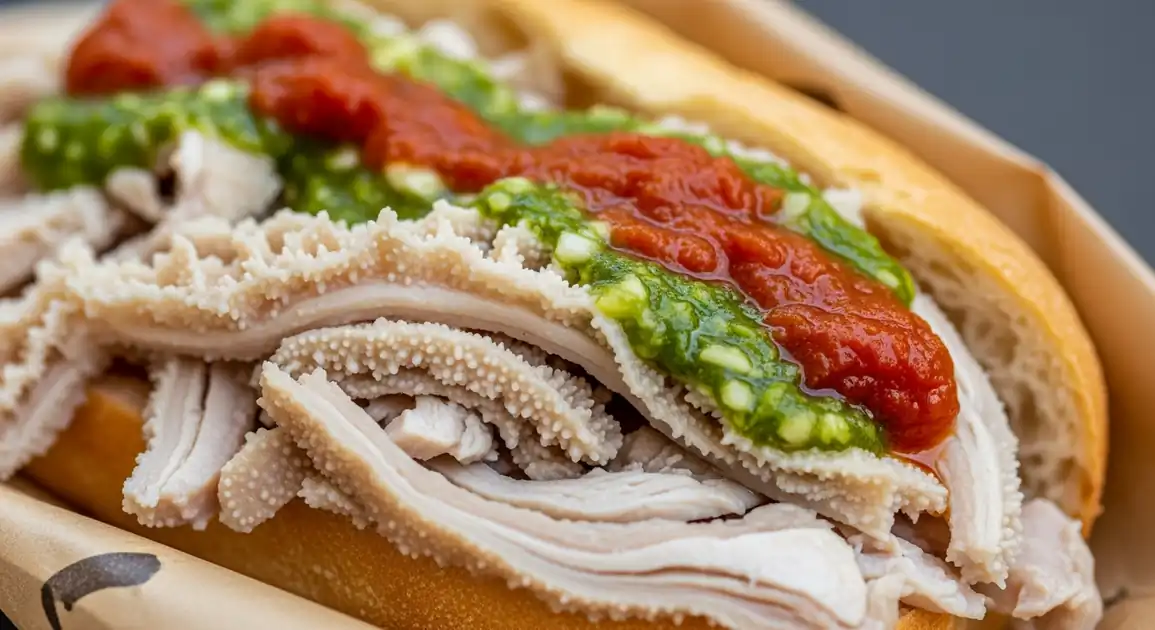Lampredotto
Lampredotto

Description
While lampredotto is predominantly associated with Florence, you can occasionally find it in other Tuscan cities. Outside of Tuscany, authentic lampredotto becomes significantly rarer, though some traditional trattorias in major cities may offer it as a nod to Florentine cuisine. Italy has a rich tradition of different tripe preparations unique to each region, but the specific lampredotto style remains distinctly Florentine.
Dietary Information
Serving information
Serving style
Typically served in paper wrapping or parchment paper. Eaten standing at the kiosk counter or taken to go. Almost always eaten immediately while hot.
Quick facts
Most lampredotto vendors operate from around 9 AM - 3 PM, though some keep longer hours (8 AM - 6 PM).
Safety Tips
What to Look For
-
Meat actively cooking in broth
Properly prepared lampredotto should be visibly cooking in a simmering broth, ensuring it maintains safe temperatures and remains moist.
-
Fresh, bright herb sauce (salsa verde)
Quality salsa verde should be vibrant green, indicating freshness. Dull, brownish sauce may be old.
-
Clean workspace and utensils
Observe the vendor's cleanliness, including the cutting board, knives, and serving area.
-
High turnover and local customers
Busy stands with regular local clientele typically ensure fresh preparation and proper food handling.
-
Separate money and food handling
Better vendors will avoid touching money and food without washing hands or using gloves in between.
What to avoid
-
Pre-sliced meat sitting out not in broth
Lampredotto should be kept in its cooking liquid until serving to maintain both food safety and quality.
-
Vendors with no visible cooking pot
Authentic lampredotto is served from its cooking vessel. Be wary of vendors who aren't cooking on-site.
-
Dirty or disorganized preparation area
Food safety concerns increase with poor hygiene practices.
-
Grey or off-colored meat
Properly cooked lampredotto should be pinkish-brown. Discoloration may indicate old meat.
-
Bread that looks stale or meat that looks dry
Both are signs that ingredients aren't fresh or have been sitting out too long.
Price information
Price range
Budget tips
- Standard lampredotto sandwiches typically cost 4-5 EUR from street vendors.
- Market stalls like those in Mercato Centrale may charge 5-7 EUR.
- Restaurants serving lampredotto often charge 8-10 EUR, sometimes as a plated dish rather than a sandwich.
- Avoid tourist-focused places with significantly higher prices than local stands.
Value indicators
- Generous meat portion that fills the bread.
- Offer of both salsa verde and piccante sauce.
- Bread properly dipped in broth ('bagnato').
- Vendor who takes time to prepare each sandwich individually.
- Complementary glass of wine or water included with purchase (at some vendors).
Where to Find This Dish
Market Areas
Concentrated around traditional markets, particularly Mercato Centrale and Sant'Ambrogio Market.
Mercato Centrale, Mercato di Sant'Ambrogio
Morning, Lunch
Historic Center
Several historic stands operate in the central tourist area, catering to both locals and visitors.
Piazza della Signoria (nearby), Piazza del Duomo (nearby)
Lunch, Afternoon
Working-class Neighborhoods
More authentic vendors can be found outside the immediate tourist center.
San Frediano district, Sant'Ambrogio district
Lunch, Afternoon
Vendor Tips
- Many traditional vendors close once they've sold out for the day.
- Some historic vendors close on Sundays; verify operating hours.
- Ask locals for their favorite stands - opinions are strong about the best 'trippaio'.
- Look for vendors who regularly stir their cooking pot - it indicates attention to quality.
How to Order
Regional Variations
-
Panino al Lampredotto Classico
(Panino al Lampredotto Classico)
The traditional preparation with the tripe sandwich topped with salsa verde (herb sauce), served on a roll with the top bread dipped in broth.
-
Lampredotto con Piccante
(Lampredotto con Piccante)
The standard sandwich with the addition of spicy red pepper sauce alongside the salsa verde.
-
Lampredotto Liscio
(Lampredotto Liscio)
A 'plain' version without sauces, allowing the pure flavor of the meat and broth to dominate.
-
Lampredotto Rifatto
(Lampredotto Rifatto)
A less common preparation where the cooked tripe is further stewed with tomato sauce, creating a richer flavor.
-
Trippa alla Fiorentina
(Trippa alla Fiorentina)
A related dish using flat tripe (different stomach chamber) rather than lampredotto, typically prepared with tomato sauce and served as a plated dish rather than a sandwich.
Cultural context
History
Dating back to the Renaissance, lampredotto has deep roots in Florence's 'cucina povera' (poor people's cooking) tradition. The name likely derives from 'lampreda' (lamprey eel) which the cooked tripe supposedly resembles. Originally, tripe vendors ('trippai') wandered streets with mobile carts, serving workers who needed affordable, filling food. During the 15th-16th centuries, they were officially organized into a guild. Today, lampredotto has transcended its humble origins to become a celebrated culinary icon of Florence, sought out by both locals and culinary tourists.
Local significance
Lampredotto is a cornerstone of Florentine culinary identity and working-class heritage. It represents the city's historic 'cucina povera' tradition of transforming humble ingredients into delicious specialties.
Eating customs
- Eaten by hand, while standing at the lampredotto stand's counter.
- Using the paper wrapping to catch drips as you eat.
- Sometimes accompanied by a small glass of local red wine or water.
- Considered acceptable to eat as street food while walking, unlike many Italian meals.